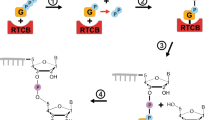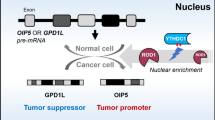Abstract
Upregulated expression of nucleolar GTPase nucleostemin (NS) has been associated with increased cellular proliferation potential and tumor malignancy during cancer development. Recent reports attribute the growth regulatory effects of NS protein to its role in facilitating ribosome production. However, the oncogenic potential of NS remains unclear, as imbalanced levels of NS have been reported to exert growth inhibitory effect by modulating p53 tumor-suppressor activity. It also remains in questions if aberrant NS levels might have a p53-independent role in regulation of cell proliferation and growth. In this study, we performed affinity purification and mass spectrometry analysis to explore protein–protein interactions influencing NS growth regulatory properties independently of p53 tumor suppressor. We identified the alternative reading frame (ARF) protein as a key protein associating with NS and further verified the interaction through in vitro and in vivo assays. We demonstrated that NS is able to regulate cell cycle progression by regulating the stability of the ARF tumor suppressor. Furthermore, overexpression of NS suppressed ARF polyubiquitination by its E3 ligase Ubiquitin Ligase for ARF and elongated its half-life, whereas knockdown of NS led to the decrease of ARF levels. Also, we found that NS can enhance NPM stabilization of ARF. Thus, we propose that in the absence of p53, ARF can be stabilized by NS and nucleophosmin to serve as an alternative tumor-suppressor surveillance, preventing potential cellular transformation resulting from the growth-inducing effects of NS overexpression.







Similar content being viewed by others
References
Boisvert FM, van Koningsbruggen S, Navascues J, Lamond AI . The multifunctional nucleolus. Nat Rev Mol Cell Biol 2007; 8: 574–585.
Narla A, Ebert BL . Ribosomopathies: human disorders of ribosome dysfunction. Blood 2010; 115: 3196–3205.
Zhang Y, Lu H . Signaling to p53: ribosomal proteins find their way. Cancer Cell 2009; 16: 369–377.
Zhou X, Liao JM, Liao WJ, Lu H . Scission of the p53-MDM2 loop by ribosomal proteins. Genes Cancer 2012; 3: 298–310.
Romanova L, Grand A, Zhang L, Rayner S, Katoku-Kikyo N, Kellner S et al. Critical role of nucleostemin in pre-rRNA processing. J Biol Chem 2009; 284: 4968–4977.
Romanova L, Kellner S, Katoku-Kikyo N, Kikyo N . Novel role of nucleostemin in the maintenance of nucleolar architecture and integrity of small nucleolar ribonucleoproteins and the telomerase complex. J Biol Chem 2009; 284: 26685–26694.
Tsai RY, McKay RD . A nucleolar mechanism controlling cell proliferation in stem cells and cancer cells. Genes Dev 2002; 16: 2991–3003.
Ye F, Zhou C, Cheng Q, Shen J, Chen H . Stem-cell-abundant proteins Nanog, Nucleostemin and Musashi1 are highly expressed in malignant cervical epithelial cells. BMC Cancer 2008; 8: 108.
Nakajima TE, Yoshida H, Okamoto N, Nagashima K, Taniguchi H, Yamada Y et al. Nucleostemin and TWIST as predictive markers for recurrence after neoadjuvant chemotherapy for esophageal carcinoma. Cancer Sci 2012; 103: 233–238.
Sijin L, Ziwei C, Yajun L, Meiyu D, Hongwei Z, Guofa H et al. The effect of knocking-down nucleostemin gene expression on the in vitro proliferation and in vivo tumorigenesis of HeLa cells. J Exp Clin Cancer Res 2004; 23: 529–538.
Zwolinska AK, Heagle Whiting A, Beekman C, Sedivy JM, Marine JC . Suppression of Myc oncogenic activity by nucleostemin haploinsufficiency. Oncogene 2011; 31: 3311–3321.
Tamase A, Muraguchi T, Naka K, Tanaka S, Kinoshita M, Hoshii T et al. Identification of tumor-initiating cells in a highly aggressive brain tumor using promoter activity of nucleostemin. Proc Natl Acad Sci USA 2009; 106: 17163–17168.
Lin T, Meng L, Li Y, Tsai RY . Tumor-initiating function of nucleostemin-enriched mammary tumor cells. Cancer Res 2010; 70: 9444–9452.
Dai MS, Sun XX, Lu H . Aberrant expression of nucleostemin activates p53 and induces cell cycle arrest via inhibition of MDM2. Mol Cell Biol 2008; 28: 4365–4376.
Ma H, Pederson T . Depletion of the nucleolar protein nucleostemin causes G1 cell cycle arrest via the p53 pathway. Mol Biol Cell 2007; 18: 2630–2635.
Tsai RY, McKay RD . A multistep, GTP-driven mechanism controlling the dynamic cycling of nucleostemin. J Cell Biol 2005; 168: 179–184.
Lo D, Dai MS, Sun XX, Zeng SX, Lu H . Ubiquitin- and MDM2 E3 ligase-independent proteasomal turnover of nucleostemin in response to GTP depletion. J Biol Chem 2012; 287: 10013–10020.
Lo D, Lu H . Nucleostemin: Another nucleolar "Twister" of the p53-MDM2 loop. Cell Cycle 2010; 9: 3227–3232.
Beekman C, Nichane M, De Clercq S, Maetens M, Floss T, Wurst W et al. Evolutionarily conserved role of nucleostemin: controlling proliferation of stem/progenitor cells during early vertebrate development. Mol Cell Biol 2006; 26: 9291–9301.
Zhang Y, Xiong Y, Yarbrough WG . ARF promotes MDM2 degradation and stabilizes p53: ARF-INK4a locus deletion impairs both the Rb and p53 tumor suppression pathways. Cell 1998; 92: 725–734.
Kamijo T, Zindy F, Roussel MF, Quelle DE, Downing JR, Ashmun RA et al. Tumor suppression at the mouse INK4a locus mediated by the alternative reading frame product p19ARF. Cell 1997; 91: 649–659.
Quelle DE, Zindy F, Ashmun RA, Sherr CJ . Alternative reading frames of the INK4a tumor suppressor gene encode two unrelated proteins capable of inducing cell cycle arrest. Cell 1995; 83: 993–1000.
Zindy F, Eischen CM, Randle DH, Kamijo T, Cleveland JL, Sherr CJ et al. Myc signaling via the ARF tumor suppressor regulates p53-dependent apoptosis and immortalization. Genes Dev 1998; 12: 2424–2433.
Chen D, Shan J, Zhu WG, Qin J, Gu W . Transcription-independent ARF regulation in oncogenic stress-mediated p53 responses. Nature 2010; 464: 624–627.
de Stanchina E, McCurrach ME, Zindy F, Shieh SY, Ferbeyre G, Samuelson AV et al. E1A signaling to p53 involves the p19(ARF) tumor suppressor. Genes Dev 1998; 12: 2434–2442.
Palmero I, Pantoja C, Serrano M . p19ARF links the tumour suppressor p53 to Ras. Nature 1998; 395: 125–126.
Radfar A, Unnikrishnan I, Lee HW, DePinho RA, Rosenberg N . p19(Arf) induces p53-dependent apoptosis during abelson virus-mediated pre-B cell transformation. Proc Natl Acad Sci USA 1998; 95: 13194–13199.
Sherr CJ . Divorcing ARF and p53: an unsettled case. Nat Rev Cancer 2006; 6: 663–673.
Lindstrom MS, Zhang Y . B23 and ARF: friends or foes? Cell Biochem Biophys 2006; 46: 79–90.
Itahana K, Bhat KP, Jin A, Itahana Y, Hawke D, Kobayashi R et al. Tumor suppressor ARF degrades B23, a nucleolar protein involved in ribosome biogenesis and cell proliferation. Mol Cell 2003; 12: 1151–1164.
Bertwistle D, Sugimoto M, Sherr CJ . Physical and functional interactions of the Arf tumor suppressor protein with nucleophosmin/B23. Mol Cell Biol 2004; 24: 985–996.
Lessard F, Morin F, Ivanchuk S, Langlois F, Stefanovsky V, Rutka J et al. The ARF tumor suppressor controls ribosome biogenesis by regulating the RNA polymerase I transcription factor TTF-I. Mol Cell 38: 539–550.
Ma H, Pederson T . Nucleophosmin is a binding partner of nucleostemin in human osteosarcoma cells. Mol Biol Cell 2008; 19: 2870–2875.
Kuo ML, den Besten W, Bertwistle D, Roussel MF, Sherr CJ . N-terminal polyubiquitination and degradation of the Arf tumor suppressor. Genes Dev 2004; 18: 1862–1874.
Huang M, Itahana K, Zhang Y, Mitchell BS . Depletion of guanine nucleotides leads to the Mdm2-dependent proteasomal degradation of nucleostemin. Cancer Res 2009; 69: 3004–3012.
Honda R, Yasuda H . Association of p19(ARF) with Mdm2 inhibits ubiquitin ligase activity of Mdm2 for tumor suppressor p53. EMBO J 1999; 18: 22–27.
Stott FJ, Bates S, James MC, McConnell BB, Starborg M, Brookes S et al. The alternative product from the human CDKN2A locus, p14(ARF), participates in a regulatory feedback loop with p53 and MDM2. EMBO J 1998; 17: 5001–5014.
Vousden KH, Lu X . Live or let die: the cell's response to p53. Nat Rev Cancer 2002; 2: 594–604.
Weber JD, Jeffers JR, Rehg JE, Randle DH, Lozano G, Roussel MF et al. p53-independent functions of the p19(ARF) tumor suppressor. Genes Dev 2000; 14: 2358–2365.
Eymin B, Leduc C, Coll JL, Brambilla E, Gazzeri S . p14ARF induces G2 arrest and apoptosis independently of p53 leading to regression of tumours established in nude mice. Oncogene 2003; 22: 1822–1835.
Sugimoto M, Kuo ML, Roussel MF, Sherr CJ . Nucleolar Arf tumor suppressor inhibits ribosomal RNA processing. Mol Cell 2003; 11: 415–424.
Lessard F, Morin F, Ivanchuk S, Langlois F, Stefanovsky V, Rutka J et al. The ARF tumor suppressor controls ribosome biogenesis by regulating the RNA polymerase I transcription factor TTF-I. Mol Cell 2010; 38: 539–550.
Maggi LB Jr, Kuchenruether M, Dadey DY, Schwope RM, Grisendi S, Townsend RR et al. Nucleophosmin serves as a rate-limiting nuclear export chaperone for the Mammalian ribosome. Mol Cell Biol 2008; 28: 7050–7065.
Brady SN, Yu Y, Maggi LB Jr, Weber JD . ARF impedes NPM/B23 shuttling in an Mdm2-sensitive tumor suppressor pathway. Mol Cell Biol 2004; 24: 9327–9338.
Bertwistle D, Sugimoto M, Sherr CJ . Physical and functional interactions of the Arf tumor suppressor protein with nucleophosmin/B23. Mol Cell Biol 2004; 24: 985–996.
Dai MS, Zeng SX, Jin Y, Sun XX, David L, Lu H . Ribosomal protein L23 activates p53 by inhibiting MDM2 function in response to ribosomal perturbation but not to translation inhibition. Mol Cell Biol 2004; 24: 7654–7668.
Acknowledgements
We thank L David at Oregon Health and Science University for conducting the mass spectrometry analysis in the affinity purification, W Gu at Columbia University for supplying the ULF reagents, and Y Dong at Tulane University School of Medicine for offering the lentivirus vector. This work was supported in part by NIH-NCI grants CA095441, CA079721, CA129828 and CA172468 to HL.
Author information
Authors and Affiliations
Corresponding author
Ethics declarations
Competing interests
The authors declare no conflict of interest.
Additional information
Supplementary Information accompanies this paper on the Oncogene website
Supplementary information
Rights and permissions
About this article
Cite this article
Lo, D., Zhang, Y., Dai, MS. et al. Nucleostemin stabilizes ARF by inhibiting the ubiquitin ligase ULF. Oncogene 34, 1688–1697 (2015). https://doi.org/10.1038/onc.2014.103
Received:
Revised:
Accepted:
Published:
Issue Date:
DOI: https://doi.org/10.1038/onc.2014.103
- Springer Nature Limited
This article is cited by
-
The oncogenic E3 ligase TRIP12 suppresses epithelial–mesenchymal transition (EMT) and mesenchymal traits through ZEB1/2
Cell Death Discovery (2021)
-
Nucleolus-derived mediators in oncogenic stress response and activation of p53-dependent pathways
Histochemistry and Cell Biology (2016)




